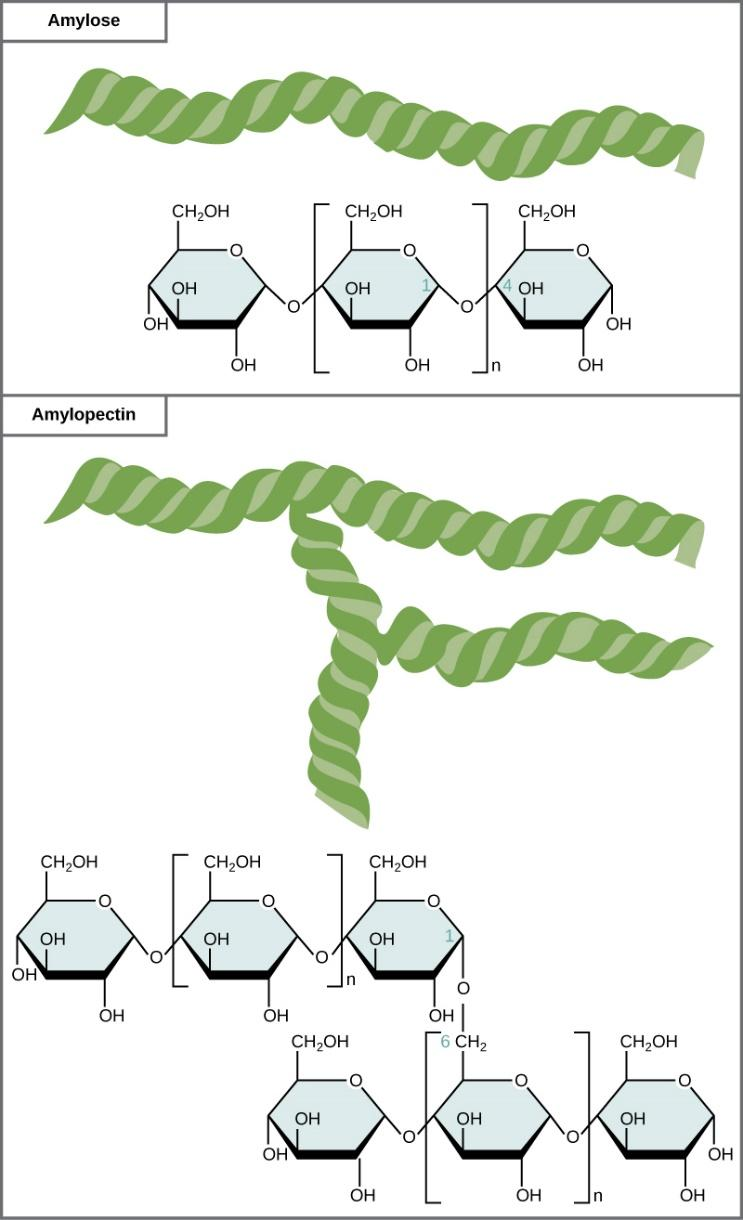Answer
39.3k+ views
Hint:
Amylopectin is a water soluble polysaccharide and highly branched polymer. It is one of the two components of starch, the other being amylose. Glucose units are linked in a linear way with $\alpha $ glycosidic bonds.
Complete step by step answer:
Starch is a colorless and odorless polysaccharide that is found in plants as stored carbohydrates. It is a polymer of glucose monomers that are linked with each other to form polysaccharide. It is composed of two types of polysaccharide molecules:
A. Amylose
B. Amylopectin
Now, we will discuss amylopectin.
Amylopectin is a polymer of several D-glucose molecules. $80\% $ of amylopectin is present in starch.
Further, the amylopectin molecules are linked by $\alpha 1,4$-glycosidic bonds and $\alpha 1,6 - $ glycosidic bonds. When iodine is added to starch, it gives reddish-brown appearance due to the presence of amylopectin. It readily dissolves in hot water.

Hence, option B is correct.
Note: Polysaccharides are large molecules that feature high molecular weights and contain hundreds of glucose units joined by $\beta $ glycosidic bonds between C-$1$ and C-$4$ sites of adjacent sugars. The most important polysaccharides are cellulose, starch and glycogen.
Amylopectin is a water soluble polysaccharide and highly branched polymer. It is one of the two components of starch, the other being amylose. Glucose units are linked in a linear way with $\alpha $ glycosidic bonds.
Complete step by step answer:
Starch is a colorless and odorless polysaccharide that is found in plants as stored carbohydrates. It is a polymer of glucose monomers that are linked with each other to form polysaccharide. It is composed of two types of polysaccharide molecules:
A. Amylose
B. Amylopectin
Now, we will discuss amylopectin.
Amylopectin is a polymer of several D-glucose molecules. $80\% $ of amylopectin is present in starch.
Further, the amylopectin molecules are linked by $\alpha 1,4$-glycosidic bonds and $\alpha 1,6 - $ glycosidic bonds. When iodine is added to starch, it gives reddish-brown appearance due to the presence of amylopectin. It readily dissolves in hot water.

Hence, option B is correct.
Note: Polysaccharides are large molecules that feature high molecular weights and contain hundreds of glucose units joined by $\beta $ glycosidic bonds between C-$1$ and C-$4$ sites of adjacent sugars. The most important polysaccharides are cellulose, starch and glycogen.
Recently Updated Pages
silver wire has diameter 04mm and resistivity 16 times class 12 physics JEE_Main

A parallel plate capacitor has a capacitance C When class 12 physics JEE_Main

Let gx 1 + x x and fx left beginarray20c 1x 0 0x 0 class 12 maths JEE_Main

A series combination of n1 capacitors each of value class 12 physics JEE_Main

When propyne is treated with aqueous H2SO4 in presence class 12 chemistry JEE_Main

Which of the following is not true in the case of motion class 12 physics JEE_Main

Other Pages
How many grams of concentrated nitric acid solution class 11 chemistry JEE_Main

A motorcycle is going on an over bridge of radius R class 11 physics JEE_Main

The mole fraction of the solute in a 1 molal aqueous class 11 chemistry JEE_Main

Differentiate between homogeneous and heterogeneous class 12 chemistry JEE_Main

Formula for number of images formed by two plane mirrors class 12 physics JEE_Main

Explain the construction and working of a GeigerMuller class 12 physics JEE_Main



